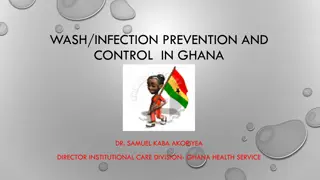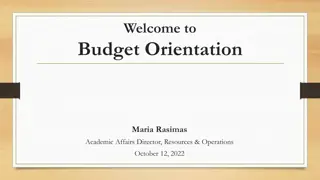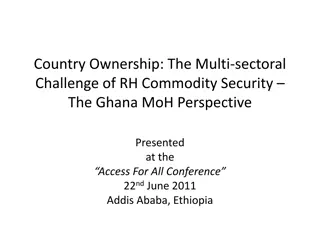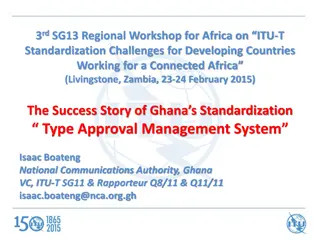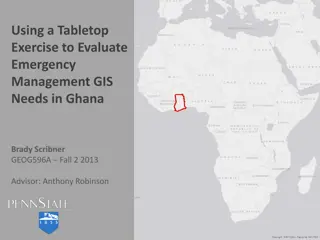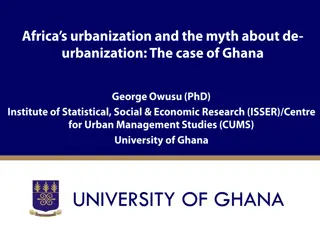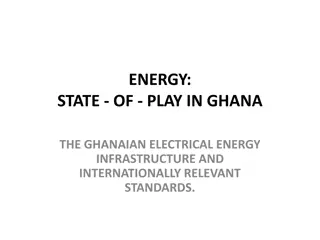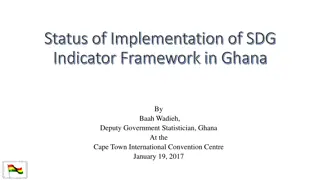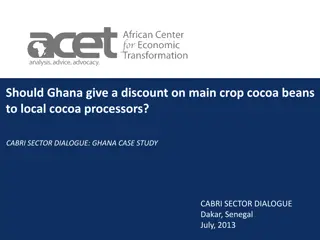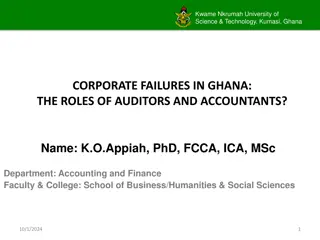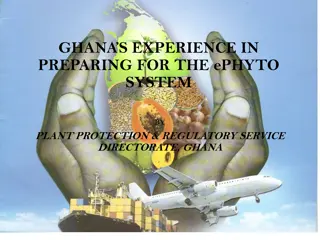Analysis of Ghana's 2018 National Budget by Prof. Peter Quartey
The review by Prof. Peter Quartey from the University of Ghana delves into the key aspects of Ghana's 2018 budget, focusing on the transition from stabilization to growth. The budget emphasizes job creation, livelihood improvements, and equal opportunities through investments in agriculture, infrastructure, human capital, and entrepreneurship. Global growth trends, fiscal developments, monetary sector, and public debt are assessed with a call for policy options to tackle jobless growth, particularly among the youth.
Download Presentation

Please find below an Image/Link to download the presentation.
The content on the website is provided AS IS for your information and personal use only. It may not be sold, licensed, or shared on other websites without obtaining consent from the author.If you encounter any issues during the download, it is possible that the publisher has removed the file from their server.
You are allowed to download the files provided on this website for personal or commercial use, subject to the condition that they are used lawfully. All files are the property of their respective owners.
The content on the website is provided AS IS for your information and personal use only. It may not be sold, licensed, or shared on other websites without obtaining consent from the author.
E N D
Presentation Transcript
ICAG REVIEW OF THE 2018 NATIONAL BUDGET BY PROF. PETER QUARTEY (HEAD, DEPT. OF ECONOMICS, UG)
OUTLINE Introduction Global Growth Trends The Real Sector Agriculture Industry Services Fiscal Developments Monetary Sector Public Debt Conclusion & Policy Options UNIVERSITY OF GHANA 2
1. INTRODUCTION Ghana s 2018 budget is prepared under the theme: From stabilization to growth: putting Ghana back to work again . This entails creating jobs, leading to livelihood improvements, prosperity and equal opportunities for all Ghanaians. This objective is to be driven by investments in Agriculture and Agribusiness, Strategic Infrastructure, Human Capital and Entrepreneurship and Innovation Programmes Also underpinned by concepts such as `One District One Factory , `One Village One Dam , `$1 million Dollars per Constituency etc UNIVERSITY OF GHANA 3
1. INTRODUCTION Very much in line with Global targets such as MDGs and SDGs (SDG 8). Jobless growth has reached an alarming point, especially among the Ghanaian youth. Total unemployment rate for Ghana is 11.9 percent and 25.9 percent for the youth (15-24) - more than two times that of adults. UNIVERSITY OF GHANA 4
2. Budget Highlights Global Growth Favourable global developments: Commodity prices generally, and particularly oil prices (but not gold or cocoa), have been rising. Global GDP growth in 2017 is projected at 3.5 percent and 3.6 percent in 2018, with positive implications for Ghana s exports and growth. Growth in advanced countries is 2.2 percent in 2017 (1.7 percent in 2016). Emerging markets and developing economies [4.3 percent in 2016; 4.6 percent in 2017 and 4.8 in 2018], with China, India, Brazil and Russia contributing to this favourable forecast (IMF, 2017). UNIVERSITY OF GHANA 5
2. Budget Highlights Global Growth Growth momentum in SSA remains fragile. In 2016, growth slowed in about two-thirds of the countries in the region and is estimated to have reached just 1.4 percent. A modest rebound to 2.5 percent expected in 2017 (largely driven by one-off factors in the three largest countries o a recovery in oil production in Nigeria o higher public spending ahead of elections in Angola o the fading of drought effects in South Africa combined with modest improvements in their terms of trade UNIVERSITY OF GHANA 6
2. Budget Highlights Continental In 2016, three (3) Member States satisfied the criterion for the Ratio of Budget Deficit (including grants) to GDP ( 3%) as compared to six (6) in 2015. public indebtedness, increased in nearly all the Member States in 2016 compared to 2015. That notwithstanding, eleven (11) member states met the criterion on Debt-to- GDP ( 70%) in both 2015 and 2016. Excludes Ghana !!!! UNIVERSITY OF GHANA 7
3. THE REAL SECTOR GDP Growth Over the past 10 years, the Ghanaian economy recorded its lowest growth (including oil) in 2016. Growth is strengthening again in 2017 (7.9% including oil and 4.8% non-oil growth) Non-oil growth has declined from 5.0% in 2016 to 4.8% in 2017. The growth performance for 2017 is highly vulnerable to external shocks (commodity prices) and could not have translated into meaningful job creation Need to transform and grow Agriculture and manufacturing o One District One Factory? o One Village One Dam? o Planting for Food and Jobs? Double digit growth + Reduce population growth rate GDP Growth 16 14 14 12 10 9.3 8 7.9 7.9 7.3 6 4.8 4 4 3.8 3.7 2 0 2009 2010 2011 2012 2013 2014 2015 2016 2017 UNIVERSITY OF GHANA 8
3. THE REAL SECTOR GDP Growth Non-Oil Growth is preferred because that is where we find most people employed not the oil sector IMF 2016 outturn is 4.0 percent and the projected figure for 2017 as 5.8 percent (IMF-SSA, April 2017). What accounts for this variance? 2017 SECTOR GROWTH Agriculture 4.3% Industry 17.7% Services 4.7% UNIVERSITY OF GHANA 9
3. THE REAL SECTOR Agriculture The structure of the economy remains largely unchanged with services sector still dominating. Lack of transformation from agriculture to industry. Rather, we are growing services at the expense of high value added production Agriculture sector expanded by 1.3% points faster in 2017 than it did in 2016 (i.e., from 3.0% to 4.3%). The sector s growth rate is the lowest among the three real sectors. Relative to 2016, fishing is the only subsector for which growth slowed down in 2017 UNIVERSITY OF GHANA 10
3. THE REAL SECTOR Agriculture Two flagship policies aimed at boosting agriculture sector performance: o the Planting for Food and Jobs campaign (PFJC) and the One Village One Dam campaign (OVODC) . Concerns: o Many of the proposed activities under the initiatives already exist in previous policy statements. o Lack of a clear plan for evaluating the impact of the policy, which is necessary for learning about what works or not and why. o MIDA Phase I contracted independent research think tank to undertake Baseline studies as well as impact evaluation The main areas of progress are: registration of farmers, recruitment of extension agents and the distribution of seeds and fertilizers to farmers. Does such subsidized hand-outs represent a sustainable medium to long- term approach to transforming agriculture? The policy though laudable should seek to address some of these concerns UNIVERSITY OF GHANA 11
3. THE REAL SECTOR Agriculture Cocoa continues to be Ghana s most important agricultural export commodity. Although production increased during the 2016/17 season, productivity remains low Another policy proposal is the plan to operationalize the pending agriculture commodities exchange and warehouse receipt system. Will address market challenges and also the warehouse receipt system could serve as an instrument for financing production activities for future production cycles. Concerns about high reliance of the agriculture sector on donor funding. Taking the ministry of agriculture alone, for example, after netting out compensation of employees, we note that approximately 24% of expenditures allocated to the sector for 2018 are expected to come from development partners Can Ghana move `Beyond Aid ? And when? UNIVERSITY OF GHANA 12
3. THE REAL SECTOR Industry Industry is estimated to grow in 2017 by 17.7% which is in sharp contrast to the -0.5% in 2016. This is largely driven by a major turnaround in petroleum and mining subsectors, which are estimated to grow by 69.2 percent and 52.3 percent respectively by end of 2017 Industry is expected to grow by 9.4% in 2018. Petroleum and mining sub-sectors will still be the major drivers of industry in 2018. Manufacturing and construction will see moderate recovery in 2018 as they did in 2017. UNIVERSITY OF GHANA 13
3. THE REAL SECTOR Industry Policy Initiatives One District, One factory o Launched in August 2017 o 191 projects have been appraised and selected for implementation. o In 2018, government will allocate a minimum of GH 2 million to each district for the implementation of the 1D1F. o Very limited information on the selection criteria o Its success depends on whether it is independently selected and devoid of Partisanship interests The National Industrial Revitalisation Programme: o Government to provide a stimulus package consisting of technical and financial support to 80 eligible companies that have already been screened for the support o Unlike 1D1F, no explicit allocation was provided in the budget for this, raising a critical concern about government s real commitment to start this programme in 2018 or anytime soon. UNIVERSITY OF GHANA 14
3. THE REAL SECTOR Industry Policy Initiatives Building an Entrepreneurial Nation oUS$10 million National Entrepreneurship and Innovation Programme (NEIP) was launched in August 2017. oThis will provide business advisory services to many enterprises as well as provide financial support to 500 of them. The Akufo-Addo Program for Economic Transformation (AAPET) oAmong many other initiatives under this programme is a commitment to abolish duties on some agricultural produce processing equipment and machinery. oThis is laudable effort on its own but will also synergise the 1D1F programme if the majority of the enterprises are in agro processing sector. UNIVERSITY OF GHANA 15
3. THE REAL SECTOR Industry Policy Initiatives Electricity Tariff Reforms o A recommendation to reduce electricity tariff by 11-21 percent for different categories of consumers including businesses has been made. o Laudable but the government could have shown more commitment by reducing some of the taxes on electricity. o Usual issue of targeting How do we ensure that poor households get most of the benefits? Providing requisite financial market o Launch of a National Development Bank o Restructuring of the Ghana Infrastructure Investment Fund (GIIF) o Enhancing the capacity of Ghana Exim Bank NIB and ADB to merge? Universal banking License or focus on Agric and manufacturing? Will interest of SMEs be served outside the formal traditional credit appraisal system? UNIVERSITY OF GHANA 16
3. THE REAL SECTOR Industry Unlike the 2017 budget, the 2018 was silent on any programme to promote made-in Ghana Using tariff and nontariff protectionist methods to shore up the competitiveness of local industries on the Ghanaian market What about the influx of cheap imported goods on the local markets? The textile industry is under siege The issue of foreigners trading cheap imported goods on the local market? UNIVERSITY OF GHANA 17
3. THE REAL SECTOR Services The sector grew by 4.7 percent in 2017, well below its projected growth rate of 7.7 percent and lower than its performance of 5.7 percent in 2016. The services sector remains the largest contributor to GDP, accounting for approximately 55.9 percent, a marginal decline from its GDP share of 56.8 percent in 2016. Key Outcomes in 2017 o Reforming and strengthening the education system - implementation of the free SHS and investment for Technical, Vocational and Agricultural Education and Training o Roll-out of free SHS to ensure equal opportunities for all and enhancement of human capital for the country; o Restoration of teachers and nurses training allowances (43,570 trainees) o Reviewing and strengthening the National Health Insurance Scheme (NHIS), LEAP, School Feeding and other social intervention programmes What about trainee allowances of those in Agricultural colleges to ensure that the Planting for Food and Jobs initiative succeeds? UNIVERSITY OF GHANA 18
3. THE REAL SECTOR Services Education To fulfil the government s mandate of free secondary education, the government paid fees of 353,053 for first year Senior High School pupils in the September 2017/18 academic year. Government supplied the full complement of core textbooks, supplementary readers and core English Literature books to all first year students. Government also released subsidy for continuing students in Senior High Schools. 100% absorption of registration fees for BECE to ensure that all basic school students sit and justify their entry into SHS. Uncoordinated Computer Placement System (a number of pupils posted to day schools outside their geographical areas, pupils from private schools severely disadvantaged) The financial burden for free SHS can be enormous in ensuing years, as new cohorts join the stream and the added pressures on infrastructure increase. Issues on sustainability - but it is commendable to notice the preparations for other sources of funding, such as the proposed Educational Fund which is earmarked for implementation in 2018. UNIVERSITY OF GHANA 19
3. THE REAL SECTOR Services Health Ghana s performance with regards to the achievement of key health indicators has been mixed. There are gaps in access to health care caused by inadequate and unequal distribution of health infrastructure and personnel Key steps undertaken in 2017, included the recruitment of 15,667 staff, comprising 11,573 nurses, 247 doctors, 1,883 support staff, 938 allied health staff and 14 physician assistants. Government paid GH 600 million out of the total government indebtedness to the National Health Insurance Scheme (NHIS) and is reviewing the recommendations of the NHIS Review report undertaken in 2016. UNIVERSITY OF GHANA 20
3. THE REAL SECTOR Services Health Currently, child mortality constitutes a major public health concern in Ghana. Ghana has made significant progress towards reducing child mortality, however institutional infant mortality per 1000 live births increased from 5.8 to 7.5 from June 2016 to June 2017. The drivers could be many but chief among them are the challenges with the procurement of vaccines, resulting in lower than targeted immunization coverage in the first half of 2017 UNIVERSITY OF GHANA 21
3. THE REAL SECTOR Services Health Water, sanitation, and hygiene do impact maternal and new-born health (MNH). Need for a stronger integration of environmental and health sector goals. Significant progress has been made on extending access to water through the Community Water and Sanitation Agency, but less progress on sanitation. In 2018, the Ministry will provide 200,000 household toilets and 20,000 institutional latrines to selected communities under the Toilet for All agenda in a bid to meet the SDG on ending open defecation. With the passage of the Law to establish the Zongo Development Fund, we expect that sanitation issues within inner cities and other communities would be resolved UNIVERSITY OF GHANA 22
3. THE REAL SECTOR Services Other Social Issues Gaming and Betting Legislation Alcohol consumption and modes of advertisement Internet Fraud Regulating Irregular Migration Unothordox Investment Companies eg. Cryto Currency etc A cryptocurrency (or crypto currency) is a digital asset designed to work as a medium of exchange The popularity of and demand for online currencies has increased since the inception of bitcoin in 2009 -such an unregulated person to person global economy that crypto currencies offer may become a threat to society. May become tools for anonymous web criminals UNIVERSITY OF GHANA 23
4. FISCAL DEVELOPMENT Core objective of 2017 budget: achieving macro stability through: ofiscal discipline ofiscal transparency ofiscal accountability and fiscal clarity The overall fiscal target was a primary surplus of 0.4% of GDP and an overall deficit of 6.5% (revised downward to 6.3% of GDP). The overall deficit on cash basis was 4.6 percent of GDP against a target of 4.8 percent while the primary balance moved into surplus - marginally lower than targeted UNIVERSITY OF GHANA 24
4. FISCAL DEVELOPMENT Fiscal deficit was financed mainly from domestic sources Included a draw down in government deposits with the Bank of Ghana Over-reliance on external finance has serious implications for the local currency eg. potential capital flight issues UNIVERSITY OF GHANA 25
4. FISCAL DEVELOPMENT Total Revenue and Grants for the period amounted to GH 28,429.2 million (14.1% of GDP) compared to a target of GH 31,346.4 million (15.5% of GDP). Represents an annual growth of 16.2 percent compared to 4.1 percent during the same period in 2016. Delays in implementation of tax compliance and administrative measures + slow real GDP growth in the non-oil sectors of the economy (Services sector), mainly accounts for the shortfalls in revenue performance International trade taxes and company taxes were the major areas of deviation from targets Hopefully, ongoing special audits and compliance measures will materialize Positive signs of enforcing compliance and should be commended but efforts should also be directed towards the informal sector GRA should be careful not to kill the Goose that lays the golden egg through excessive aggression Does Paperless system reduce the degree of discretion in tax assessment? UNIVERSITY OF GHANA 26
4. FISCAL DEVELOPMENT Total Expenditure, including the clearance of arrears amounted to GH 37,705.0 million (18.7% of GDP) compared to the target of GH 41,036.2 million, 8.1 percent below target Interest Payments through September of 2017, amounted to GH 9,710.3 million (5.5% lower than the period target) The wage bill amounted to GH 10,696.7 million constituting about 48 percent of Tax Revenues, marginally higher than the target of GH 10,520.4 million Wages and related arrears carried over from last year A greater proportion of revenue spent on wages and salaries, interest payments and statutory payments leaving little for development expenditure Major decline in capital expenditure from the 2017 target by about 21% which has implications for growth, especially if this has direct links with the productive sectors UNIVERSITY OF GHANA 27
4. FISCAL DEVELOPMENT 2018 Fiscal Projections The government in 2018 seeks to further strengthen macro stability A deficit target of 4.5% of GDP and a primary surplus target of 1.6% of GDP. These targets are set based on the assumption that: otax revenue will increase by about 25% relative to the 2017 provisional levels whilst expenditure will increase by about 19% in 2018. oAlso it is anticipated that capital spending will increase by about 50% relative to the 2017 provisional levels. Is Government too optimistic about these numbers? UNIVERSITY OF GHANA 28
4. FISCAL DEVELOPMENT 2018 Fiscal Projections The revenue performance must be good and targets met. Should revenue targets be missed, the government may again be forced to sacrifice capital spending and consequently medium term growth. It is important that government remains disciplined with respect to its spending. Immediate, post-election year is usually one that successive governments have done well fiscally but not thereafter. Fiscal discipline is necessary to ensure that the macroeconomic gains made in 2017 can be further consolidated. UNIVERSITY OF GHANA 29
5. MONETARY DEVELOPMENT Monetary policy in 2017 focused mainly on re-anchoring inflation expectations and directing inflation towards the medium term target of 8 2 percent. The outcome for the year showed some marginal gains though below expectations: The year recorded a downward trend in inflation from 15.4% by end December 2016 to 11.6% in October 2017 but this was higher than the medium term target of 8 2 percent UNIVERSITY OF GHANA 30
5. MONETARY DEVELOPMENT Credit to the private sector expanded by 4.2% in September 2017 compared to 3.6% growth recorded in the same period last year in the midst of the rising non-performing loans. There were some marginal improvements in the share of credit to Agriculture and manufacturing, two major labour-intensive sectors of the economy. The share of Domestic Money Bank credit to Agriculture increased from 3.7% in December 2016 to 3.9% in September 2017 while the share of DMB credit to manufacturing also increased from 7.7% to 8.5% over the same period. UNIVERSITY OF GHANA 31
5. MONETARY DEVELOPMENT These developments if sustained and coupled with other policy initiatives can stimulate the growth of the private sector to create jobs. The Monetary Policy Rate declined to 21% during 2017 while the money market rates (Treasury Bill rates) also declined The 91-day TB rate declined by 3.6 percentage points. Average lending rates on the interbank market declined from 28.97% in September 2017 from 31.68% in December 2016. UNIVERSITY OF GHANA 32
5. MONETARY DEVELOPMENT The relative stability in the exchange rate coupled with downward inflation trends and the marginal decline in the lending rate is likely to translate into improvements in the cost of doing business and can stimulate the private sector The macroeconomic target for 2018 aims to restore and sustain macroeconomic stability. Also consistent with the medium term development policy framework, the specific target for 2018 is an inflation rate of 8.9%. This if achieved will make Ghana improve on the number of ECOWAS convergence criteria indicators the country has met. It will be recalled; that Ghana and Gambia recorded the lowest number of indicators (2) met in 2016 compared to its counterparts who met 4- 6 indicators in 2016. UNIVERSITY OF GHANA 33
5. PUBLIC DEBT Government debt now stands at some 138.87 billion Ghana cedis, or 68.27% of GDP at the end of September 2017, down from 73.1% at the end of 2016. This means that by September 2017, every Ghanaian citizen was indebted to Ghana s creditors to the tune of about GHC 5,100 (About $1108). If we factor in ESLA Bonds ( 4783.97 million) as requested by IMF, total debt will amount to GH 143.654 billion) and Debt GDP will be about 73.6%. The total debt stock (138.87 billion Ghana cedis) represented over 330 percent of total revenue and over 430 percent of tax revenue. Interest payments on the public debt stood at some 9.7 billion Ghana cedis and is projected to rise to nearly 15 billion Ghana cedis by close of 2018, representing one of the fastest-growing items of expenditure in the budget UNIVERSITY OF GHANA 34
5. PUBLIC DEBT The zeal to resort to external borrowing poses a macroeconomic risk. As the debt burden continues to escalate, continuing currency depreciation could lead to a rapid increase in the value of foreign-currency denominated debt Interest payments increase beyond sustainable levels UNIVERSITY OF GHANA 35
5. PUBLIC DEBT Year Debt Service-Exports Debt Service- Revenue DEBT SUSTAINABILITY AND HIPC THRESHOLDS Ghana s debt service to exports ratio is above the eHIPC Thresholds (15-20%) and close to 2001 (HIPC Levels) Debt Service to Revenue ratio is above eHIPC Thresholds and about half of 2001 level (HIPC Level) 2001 24.3 60.5 2002 24.6 33.2 2003 23.0 24.9 2004 17.2 28.4 2005 15.9 24.4 2006 13.3 24.6 2007 13.4 20.8 2008 15.6 23.9 2009 13.8 23.9 2010 9.7 17.1 2011 7.6 15.9 2012 7.2 14.2 2013 13.9 22.7 2014 17.6 31.7 2015 15.4 32.8 2016 23.2 29.7 UNIVERSITY OF GHANA 36
5. PUBLIC DEBT Debt Re-profiling: Government in April 2017 issued a new 15- year bond, together with a second 7-year bond. The proceeds, was largely used to re-profile maturing 91-Day and 182-Day Treasury bills This will free government from the usual pressure when these instruments are about to mature Raising more domestic revenue and getting value from our resources is certainly the way to go UNIVERSITY OF GHANA 37
6. CONCLUSIONS AND POLICY LESSONS 6. CONCLUSIONS AND POLICY LESSONS Favourable global outlook for 2017 and 2018 with some positive implications for Ghana The estimated 7.9 percent growth in 2017 though commendable, has been driven mainly by increased production and booming prices of Ghana s main commodity exports. As such the sources of growth in Ghana remains highly vulnerable to external shocks The less than desired growth in the non-oil sector is a source of concern. There is high unemployment rate and therefore growth should be targeted at the non-oil sectors that generate the most jobs The one district one factory policy , the one village one dam policy together with the planting for food and agricultural program if well-planned and implemented will boost the agricultural sector, serving as backward linkage to the manufacturing sector. UNIVERSITY OF GHANA 38
6. CONCLUSIONS AND POLICY LESSONS 6. CONCLUSIONS AND POLICY LESSONS Government Policy Initiatives on Agriculture and Industry is laudable but should be devoid of the usual partisanship influences in order to be successful In the area of services, the Financial sustainability of the `Free SHS programme is very critical. Also, 2018 should witness better and well integrated placement system to avoid the chaos witnessed in 2017 Better health systems is key and well integrated into a value for money sanitation programme The revenue and expenditure targets are very ambitious. GRA should continue to cautiously pursue its revenue mobilization drive Need to reduce the proportion of revenue spent on wages and salaries by removing Ghost names as well as reducing interest payments UNIVERSITY OF GHANA 39
6. CONCLUSIONS AND POLICY LESSONS 6. CONCLUSIONS AND POLICY LESSONS The Central Bank should continue to pursue inflation, interest rate and exchange rate policies that will promote private sector activities. Also regulate unothordox financial investment institutions such as crypto currencies National Investment Bank laudable but merging ADB and NIB should be accompanied by policies that will change their mode of operations in favour of SMES. Universal license? Debt sustainability remains a major concern and steps should be taken to reduce it now that we speaking about `Ghana Beyond Aid . UNIVERSITY OF GHANA 40




